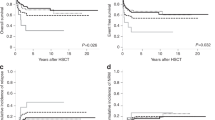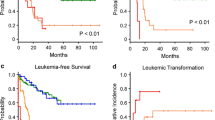Abstract
The prognostic value of karyotype in patients with myelodysplastic syndrome (MDS) is generally appreciated. However, the factors that are predictive of prognosis of patients with abnormal karyotypes are not known. In this study, we evaluated the prognostic value of International Prognostic Scoring System (IPSS) and World Health Organization classification-based prognostic scoring system (WPSS) in 164 adult MDS patients with abnormal karyotypes. We also analyzed the prognostic relevance of mean corpuscular volume (MCV) in these patients. We found that both IPSS and WPSS had strong prognostic value in patients with abnormal karyotypes (P < 0.001, P < 0.001). Furthermore, we observed the significant differences in the survival of patients with abnormal karyotypes based on MCV stratification: The median survival of patients with macrocytosis was 31.0 months, significantly longer than the 16.5-month median survival time of patients with MCVs of less than 100 fl (P = 0.001). Multivariate analysis revealed that lower level of hemoglobin (P = 0.012, HR = 6.83), higher level of marrow blasts (P < 0.001, HR = 1.93), complex karyotype (P = 0.001, HR = 3.32), and MCV of less than 100 fl (P = 0.026, HR = 1.75) were independent risk factors that affected the survival of patients with abnormal karyotypes.



Similar content being viewed by others
References
Tricot G, Vlietinck R, Boogaerts MA, Hendrickx B, De Wolf-Peeters C, Van den Berghe H, Verwilghen RL (1985) Prognostic factors in the myelodysplastic syndromes: importance of initial data on peripheral blood counts, bone marrow cytology, trephine biopsy and chromosomal analysis. Br J Haematol 60:19–32
Goasguen JE, Garand R, Bizet M, Bremond JL, Gardais J, Callat MP, Accard F, Chaperon J (1990) Prognostic factors of myelodysplastic syndromes—a simplified 3-D scoring system. Leuk Res 14:255–262
Sanz GF, Sanz MA, Greenberg PL (1998) Prognostic factors and scoring systems in myelodysplastic syndromes. Haematologica 83:358–368
Mufti GJ, Stevens JR, Oscier DG, Hamblin TJ, Machin D (1985) Myelodysplastic syndromes: a scoring system with prognostic significance. Br J Haematol 59:425–433
Sanz GF, Sanz MA, Vallespi T, Canizo MC, Torrabadella M, Garcia S, Irriguible D, San Miguel JF (1989) Two regression models and a scoring system for predicting survival and planning treatment in myelodysplastic syndromes: a multivariate analysis of prognostic factors in 370 patients. Blood 74:395–408
Morel P, Hebbar M, Lai JL, Duhamel A, Preudhomme C, Wattel E, Bauters F, Fenaux P (1993) Cytogenetic analysis has strong independent prognostic value in de novo myelodysplastic syndromes and can be incorporated in a new scoring system: a report on 408 cases. Leukemia 7:1315–1323
Greenberg P, Cox C, LeBeau MM, Fenaux P, Morel P, Sanz G, Sanz M, Vallespi T, Hamblin T, Oscier D, Ohyashiki K, Toyama K, Aul C, Mufti G, Bennett J (1997) International scoring system for evaluating prognosis in myelodysplastic syndromes. Blood 89:2079–2088
Pfeilstocker M, Reisner R, Nosslinger T, Gruner H, Nowotny H, Tuchler H, Schlogl E, Pittermann E, Heinz R (1999) Cross-validation of prognostic scores in myelodysplastic syndromes on 386 patients from a single institution confirms importance of cytogenetics. Br J Haematol 106:455–463
Takahashi M, Takahashi H, Aizawa Y, Koike T (1998) Usefulness of IPSS for the patients with refractory anemia. Am J Hematol 58:250–252
Vardiman JW, Harris NL, Brunning RD (2002) The World Health Organization (WHO) classification of the myeloid neoplasms. Blood 100:2292–2302
Germing U, Gattermann N, Strupp C, Aivado M, Aul C (2000) Validation of the WHO proposals for a new classification of primary myelodysplastic syndromes: a retrospective analysis of 1600 patients. Leuk Res 24:983–992
Nosslinger T, Reisner R, Koller E, Gruner H, Tuchler H, Nowotny H, Pittermann E, Pfeilstocker M (2001) Myelodysplastic syndromes, from French–American–British to World Health Organization: comparison of classifications on 431 unselected patients from a single institution. Blood 98:2935–2941
Howe RB, Porwit-MacDonald A, Wanat R, Tehranchi R, Hellstrom-Lindberg E (2004) The WHO classification of MDS does make a difference. Blood 103:3265–3270
Malcovati L, Porta MG, Pascutto C, Invernizzi R, Boni M, Travaglino E, Passamonti F, Arcaini L, Maffioli M, Bernasconi P, Lazzarino M, Cazzola M (2005) Prognostic factors and life expectancy in myelodysplastic syndromes classified according to WHO criteria: a basis for clinical decision making. J Clin Oncol 23:7594–7603
Matsuda A, Germing U, Jinnai I, Misumi M, Kuendgen A, Knipp S, Aivado M, Iwanaga M, Miyazaki Y, Tsushima H, Sakai M, Bessho M, Tomonaga M (2005) Difference in clinical features between Japanese and German patients with refractory anemia in myelodysplastic syndromes. Blood 106:2633–2640
Germing U, Strupp C, Kuendgen A, Isa S, Knipp S, Hildebrandt B, Giagounidis A, Aul C, Gattermann N, Haas R (2006) Prospective validation of the WHO proposals for the classification of myelodysplastic syndromes. Haematologica 91:1596–1604
Malcovati L, Germing U, Kuendgen A, Della Porta MG, Pascutto C, Invernizzi R, Giagounidis A, Hildebrandt B, Bernasconi P, Knipp S, Strupp C, Lazzarino M, Aul C, Cazzola M (2007) Time-dependent prognostic scoring system for predicting survival and leukemic evolution in myelodysplastic syndromes. J Clin Oncol 25:3503–3510
Linman JW, Bagby GC Jr (1978) The preleukemic syndrome (hemopoietic dysplasia). Cancer 42:854–864
Bowen DT, Jacobs A (1989) Primary acquired sideroblastic erythropoiesis in non-anaemic and minimally anaemic subjects. J Clin Pathol 42:56–58
Tennant GB, Al-Sabah AI, Burnett AK (2002) Prognosis of myelodysplasic patients: non-parametric multiple regression analysis of populations stratified by mean corpuscular volume and marrow myeloblast number. Br J Haematol 119:87–96
Matsuda A, Misumi M, Yoshida K, Yagasaki F, Ito Y, Kawai N, Bessho M (2003) Is macrocytosis a favourable prognostic factor in myelodysplastic syndrome patients without increased blasts? Br J Haematol 121:815–816
Holtan SG, Santana-Davila R, Dewald GW, Khetterling RP, Knudson RA, Hoyer JD, Chen D, Hanson CA, Porrata L, Tefferi A, Steensma DP (2008) Myelodysplastic syndromes associated with interstitial deletion of chromosome 5q: clinicopathologic correlations and new insights from the pre-lenalidomide era. Am J Hematol 83:708–713
Mitelman F (ed) (1995) An international system for human cytogenetic nomenclature. S Karger, Basel
Brunning RD, Orazi A, Germing U et al (2008) World Health Organization classification of tumours. Pathology & genetics tumours of haematopoietic and lymphoid tissues. IARC Press, Lyon
Lee JH, Shin YR, Lee JS, Kim WK, Chi HS, Park CJ, Seo EJ, Lee KH (2003) Application of different prognostic scoring systems and comparison of the FAB and WHO classifications in Korean patients with myelodysplastic syndrome. Leukemia 17:305–313
Chen B, Zhao WL, Jin J, Xue YQ, Cheng X, Chen XT, Cui J, Chen ZM, Cao Q, Yang G, Yao Y, Xia HL, Tong JH, Li JM, Chen J, Xiong SM, Shen ZX, Waxman S, Chen Z, Chen SJ (2005) Clinical and cytogenetic features of 508 Chinese patients with myelodysplastic syndrome and comparison with those in Western countries. Leukemia 19:767–775
Shu XO, Gao YT, Brinton LA, Linet MS, Tu JT, Zheng W, Fraumeni JF Jr (1988) A population-based case–control study of childhood leukemia in Shanghai. Cancer 62:635–644
Deschler B, de Witte T, Mertelsmann R, Lubbert M (2006) Treatment decision-making for older patients with high-risk myelodysplastic syndrome or acute myeloid leukemia: problems and approaches. Haematologica 91:1513–1522
Alessandrino EP, Amadori S, Barosi G, Cazzola M, Grossi A, Liberato LN, Locatelli F, Marchetti M, Morra E, Rebulla P, Visani G, Tura S (2002) Evidence- and consensus-based practice guidelines for the therapy of primary myelodysplastic syndromes. A statement from the Italian Society of Hematology. Haematologica 87:1286–1306
Estey E, Thall P, Beran M, Kantarjian H, Pierce S, Keating M (1997) Effect of diagnosis (refractory anemia with excess blasts, refractory anemia with excess blasts in transformation, or acute myeloid leukemia [AML]) on outcome of AML-type chemotherapy. Blood 90:2969–2977
Benitez J, Martinez Frejo C, Toledo C, Sanchez Fayos J, Ramos C (1987) Leukemic transformation in patients with the 5q-alteration: analysis of the behavior of the 5q-clones in preleukemic to leukemic phases. Cancer Genet Cytogenet 26:199–207
Haase D, Fonatsch C, Freund M (1992) Karyotype instability in myelodysplastic syndromes—a specific step in pathogenesis preceding clonal chromosome anomalies. Leuk Lymphoma 8:221–228
Author information
Authors and Affiliations
Corresponding author
Electronic supplementary material
Below is the link to the electronic supplementary material.
Supplementary Table 1
Clinical characteristics and median survival of specific cytogenetic abnormalities according to the International Prognostic Scoring System risk groups. (DOC 32 kb)
Rights and permissions
About this article
Cite this article
Wang, H., Wang, X., Xu, X. et al. Mean corpuscular volume predicts prognosis in MDS patients with abnormal karyotypes. Ann Hematol 89, 671–679 (2010). https://doi.org/10.1007/s00277-010-0912-6
Received:
Accepted:
Published:
Issue Date:
DOI: https://doi.org/10.1007/s00277-010-0912-6




